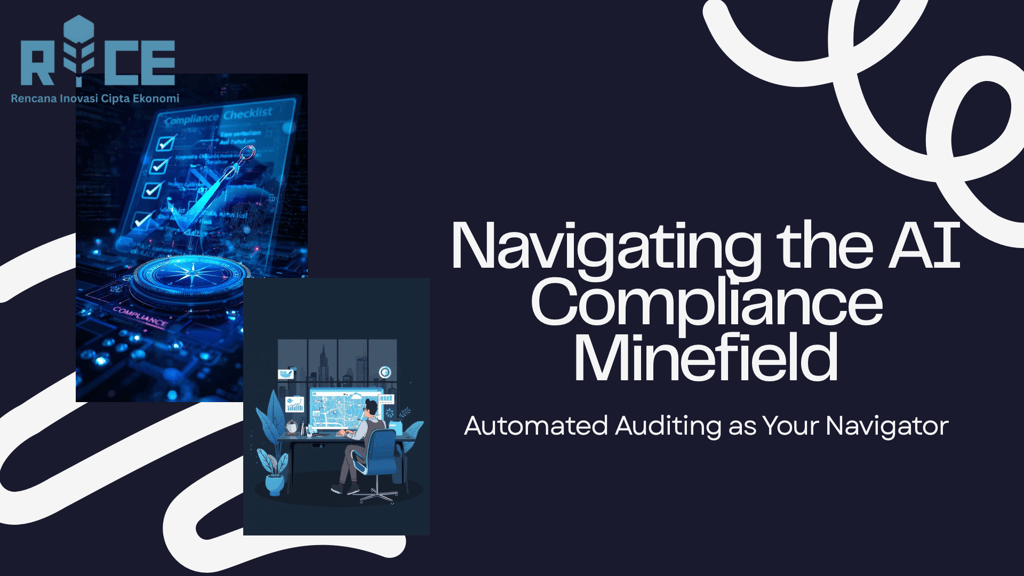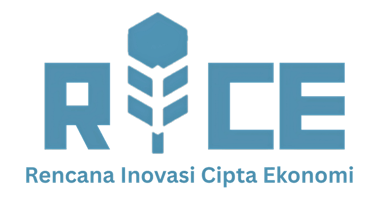Navigating the AI Compliance Minefield: Automated Auditing as Your Essential Navigator
This deep dive reveals how real-time oversight ensures ethical, transparent, and legally sound AI deployments for future-proofed innovation.
TECHNOLOGY
Rice AI (Ratna)
10/21/20259 min read


The future of artificial intelligence is undeniably transformative, promising unprecedented efficiencies and innovations across every sector. Yet, as AI systems become more sophisticated and integrated into critical operations, a complex web of ethical considerations, regulatory demands, and operational risks emerges. Ignoring this "AI compliance minefield" is no longer an option; it's a direct threat to trust, market reputation, and legal standing. Organizations today face the urgent challenge of ensuring their AI deployments are not only effective but also fair, transparent, and compliant with an ever-evolving global regulatory landscape.
This isn't merely about ticking boxes; it's about building foundational trust in autonomous systems. Proactively addressing AI compliance is paramount for future-proofing your business, fostering innovation responsibly, and maintaining a competitive edge. The sheer scale and speed of AI development demand solutions that are equally agile and robust. This is where automated auditing solutions step in, offering a strategic pathway through the complexities to ensure responsible and ethical AI deployment. These tools are transforming how organizations approach AI governance, turning what could be a bottleneck into a catalyst for secure and trusted AI.
The Growing Imperative for AI Compliance
The global regulatory environment for AI is rapidly taking shape, creating a significant compliance burden for businesses. From Europe’s comprehensive AI Act to emerging frameworks in North America and Asia, the emphasis is on accountability, transparency, and fairness. Non-compliance can lead to severe penalties, reputational damage, and a loss of consumer trust. Beyond legal mandates, ethical considerations demand that AI systems do not perpetuate bias, infringe on privacy, or make opaque decisions affecting individuals. Organizations must navigate these multifaceted demands effectively.
The inherent "black box" nature of many advanced AI models, coupled with their dynamic learning capabilities, complicates traditional auditing methods. Manually tracing data lineage, verifying algorithmic fairness, or ensuring continuous ethical alignment across thousands of daily decisions is impractical, if not impossible. This complexity underscores the urgent need for a systematic, scalable approach to AI governance. Understanding the criticality of these challenges is the first step toward effective mitigation, preparing organizations to embrace AI safely.
What is Automated AI Auditing?
Automated AI auditing leverages artificial intelligence and machine learning to continuously monitor, evaluate, and report on the compliance posture of other AI systems. Unlike periodic manual audits, automated solutions provide real-time visibility into model behavior, data flows, and decision-making processes. This continuous oversight is crucial in environments where AI models constantly evolve and interact with new data. It allows organizations to identify and address potential compliance deviations before they escalate into significant issues.
The core objective is to ensure that AI systems operate within predefined ethical guidelines, regulatory requirements, and performance standards. This encompasses a range of capabilities, from tracking data inputs and outputs to analyzing model predictions for fairness and explainability. By automating these processes, businesses can achieve a level of scrutiny and consistency that human auditors alone cannot match, transforming reactive compliance into proactive risk management. For instance, Rice AI’s platform is engineered to integrate seamlessly into existing AI workflows, providing comprehensive, real-time auditing capabilities designed for modern enterprises.
Key Components of Automated AI Auditing
Automated auditing systems comprise several critical functionalities working in concert. These components address different facets of the AI lifecycle, from data ingestion to model deployment and ongoing operation. Understanding these elements is essential for implementing a holistic and effective compliance strategy. Each component plays a vital role in constructing a complete picture of an AI system's adherence to required standards.
* Model Monitoring: Continuously tracks model performance, drift, and data integrity.
* Data Lineage Tracking: Provides a clear audit trail of data from source to model output.
* Bias Detection: Identifies unfair or discriminatory outcomes based on protected attributes.
* Explainability (XAI) Tools: Offers insights into how and why an AI model makes specific decisions.
* Regulatory Mapping: Connects internal policies and model behaviors to external legal requirements.
Core Pillars of Effective Automated Auditing
Effective automated auditing relies on a foundational set of principles and technological capabilities. These pillars ensure that an AI system's entire lifecycle, from data input to decision output, is subject to continuous scrutiny and validation against compliance requirements. Addressing each pillar systematically strengthens an organization's overall AI governance framework.
Data Integrity and Provenance
The reliability and ethical sourcing of data are fundamental to compliant AI systems. Automated auditing solutions track data from its origin through all transformation stages, ensuring its integrity and verifying its ethical collection and usage. This process helps prevent "garbage in, garbage out" scenarios, where biased or corrupted data can lead to discriminatory or inaccurate model outputs. Establishing clear data provenance is critical for accountability. It enables organizations to demonstrate that their AI models are built on sound and ethically acquired datasets.
Robust data lineage capabilities allow auditors to pinpoint exactly where data originated, how it was processed, and who accessed it. This transparency is crucial for complying with data protection regulations like GDPR and CCPA. Furthermore, it supports investigations into model failures or biased outcomes, providing a clear trail back to the root cause.
Algorithmic Transparency and Explainability (XAI)
The ability to understand an AI model’s decision-making process is no longer a luxury but a regulatory necessity. Automated auditing tools incorporate Explainable AI (XAI) techniques to shed light on opaque algorithms. These tools can identify the features most influential in a model's prediction, trace decision paths, and provide human-understandable justifications for outcomes. This transparency is vital for building trust with users and regulators.
XAI helps address concerns about fairness and accountability by making AI decisions interpretable. It allows organizations to analyze why a loan application was denied or a medical diagnosis was made, ensuring that the reasons align with ethical and legal standards. Without automated XAI capabilities, assessing complex AI models for bias or unwarranted discrimination would be an insurmountable task. External Link Suggestion: [Learn about NIST's AI Risk Management Framework]
Bias Detection and Mitigation
Algorithmic bias is a significant compliance risk, capable of perpetuating and even amplifying societal inequalities. Automated auditing systems are designed to proactively detect bias across various demographic groups and sensitive attributes. They employ statistical methods and fairness metrics to assess whether models are producing equitable outcomes for all users. This continuous monitoring is essential because bias can emerge or shift over time as models interact with new data.
Once detected, automated tools can also assist in identifying the sources of bias and suggesting mitigation strategies, from data re-sampling to model retraining. Regular, automated bias checks are critical for maintaining ethical AI deployments and avoiding discriminatory practices. Rice AI provides advanced bias detection modules that offer granular insights, empowering teams to correct disparities swiftly and effectively. Our solutions help ensure your AI systems serve all populations equitably.
Performance and Drift Monitoring
AI models are not static; their performance can degrade over time due to changes in real-world data distributions (data drift) or concept drift, where the relationship between inputs and outputs changes. Automated auditing solutions continuously monitor model performance metrics and detect any significant drift from expected behavior. This proactive monitoring ensures that models remain accurate, reliable, and compliant with their original design specifications.
Detecting drift early is vital for maintaining the integrity of AI systems, especially in critical applications like fraud detection or medical diagnosis. A drop in accuracy or a shift in predictions could lead to non-compliant outcomes or operational failures. Automated systems alert operators to these changes, allowing for timely intervention and retraining, thereby maintaining optimal and compliant performance.
Regulatory Mapping and Reporting
Navigating the labyrinth of global AI regulations requires more than just understanding the rules; it demands concrete proof of adherence. Automated auditing solutions excel at mapping internal AI practices and model behaviors directly to specific regulatory requirements. They can generate comprehensive, auditable reports that demonstrate compliance with frameworks like the EU AI Act, industry-specific guidelines, or internal ethical policies. This capability significantly reduces the manual effort and complexity associated with preparing for audits.
By automating reporting, organizations can provide regulators with transparent and verifiable evidence of their responsible AI practices. This not only streamlines the audit process but also builds a strong foundation of trust with oversight bodies. The ability to quickly and accurately produce compliance documentation is a strategic advantage in today's increasingly regulated AI landscape.
Implementing Automated Auditing Solutions
Adopting automated AI auditing is a strategic decision that requires careful planning and execution. A phased approach, tailored to an organization's specific needs and existing AI infrastructure, generally yields the best results. Successful implementation involves more than just deploying technology; it requires cultural shifts and clear operational procedures.
A Step-by-Step Approach
1. Define Scope and Objectives: Clearly identify which AI systems require auditing, what specific compliance risks need addressing, and what regulatory frameworks apply. Setting clear objectives ensures the auditing solution is aligned with business priorities.
2. Select the Right Solution: Evaluate automated auditing platforms based on their capabilities, scalability, integration options, and alignment with your technological stack. Consider vendor expertise and support. Rice AI offers a robust platform designed with scalability and comprehensive compliance in mind, perfectly suited for diverse organizational needs.
3. Integrate with Existing AI Workflows: Seamless integration with MLOps pipelines, data governance tools, and existing monitoring systems is crucial. The auditing solution should enhance, not disrupt, current development and deployment processes.
4. Establish Reporting and Alerting Mechanisms: Configure dashboards, alerts, and report templates to provide actionable insights to relevant stakeholders. Ensure that non-compliance events trigger immediate notifications for prompt resolution.
5. Continuous Improvement and Iteration: AI compliance is an ongoing journey. Regularly review the effectiveness of your automated auditing solution, adapt it to new regulations, and incorporate feedback from internal and external audits.
Considerations for Choosing a Solution
When selecting an automated auditing solution, several factors warrant careful consideration. The right choice will depend on your organization's size, industry, regulatory exposure, and the maturity of its AI initiatives. Prioritizing these aspects will lead to a more successful and impactful deployment.
* Scalability: Can the solution handle your current and future volume of AI models and data?
* Integration Capabilities: Does it integrate seamlessly with your existing data platforms, MLOps tools, and cloud environments?
* Ease of Use: Is the interface intuitive, and can your teams quickly adopt and utilize its features effectively?
* Regulatory Alignment: Does the solution specifically address the compliance requirements relevant to your industry and geography?
* Vendor Expertise: Does the provider offer strong support, deep AI compliance knowledge, and a clear roadmap for future development?
The Strategic Advantages for Organizations
Moving beyond basic compliance, automated AI auditing offers significant strategic advantages that can differentiate organizations in the marketplace. It transforms what might be seen as a necessary cost into a powerful enabler of trust, efficiency, and innovation. Embracing these solutions positions businesses as leaders in responsible AI development.
Risk Reduction
Automated auditing significantly reduces legal, financial, and reputational risks associated with AI deployment. By continuously monitoring for bias, drift, and non-compliance, organizations can preemptively address issues before they escalate into costly fines or public backlash. This proactive stance minimizes exposure to regulatory penalties and protects brand integrity. It ensures that AI systems contribute positively to business objectives without introducing unforeseen liabilities.
Operational Efficiency
Automating compliance checks frees up valuable human resources, allowing data scientists, engineers, and legal teams to focus on higher-value tasks. The speed and consistency of automated audits mean that compliance processes are no longer bottlenecks in AI development and deployment. This efficiency translates into faster time-to-market for new AI applications and a more streamlined operational workflow. It ensures that innovative solutions can be delivered without compromising governance standards.
Enhanced Trust and Reputation
In an era where consumers and regulators are increasingly scrutinizing AI, demonstrating a commitment to ethical and compliant AI builds profound trust. Organizations that publicly embrace automated auditing showcase their dedication to responsible AI. This transparency enhances customer loyalty, strengthens stakeholder relationships, and positions the company as a leader in the ethical AI movement. A strong reputation for responsible AI can be a significant competitive differentiator.
Innovation Acceleration
Paradoxically, robust compliance frameworks, particularly those enabled by automated auditing, can accelerate innovation. By providing a clear, monitored pathway for ethical AI development, these solutions empower teams to experiment and deploy new AI applications with confidence. Knowing that potential risks are continuously assessed and mitigated allows for more agile and fearless innovation, preventing costly missteps and fostering a culture of responsible experimentation. Rice AI is built on this principle, enabling organizations to push the boundaries of AI while staying firmly within compliance limits.
Competitive Edge
Organizations that master AI compliance through automated auditing gain a distinct competitive advantage. They can deploy AI solutions faster, with greater assurance, and with a stronger reputation for ethical practice. This capability attracts top talent, secures partnerships, and appeals to a growing segment of consumers and investors who prioritize responsible technology. It signals market leadership and a forward-thinking approach to the digital economy.
Conclusion
The journey through the AI compliance minefield is complex, but automated auditing solutions offer a robust and reliable navigator. As AI continues to reshape our world, the imperative for ethical, transparent, and compliant systems will only intensify. Organizations that embrace automated auditing today are not just meeting regulatory mandates; they are strategically positioning themselves for a future where trust and responsibility are paramount. The ability to continuously monitor, evaluate, and report on AI systems with precision and speed is no longer a luxury, but a fundamental requirement for sustainable growth.
By investing in these advanced tools, businesses can transform potential compliance challenges into strategic opportunities, fostering innovation while safeguarding their reputation and securing their operational integrity. This proactive approach ensures that AI serves as a powerful force for good, unlocking its full potential responsibly. Don't let the complexities of AI compliance hinder your progress. Explore how automated auditing can transform your AI governance strategy. Contact Rice AI today for a personalized consultation or demo and start navigating the future of AI with confidence.
#AICompliance #AutomatedAuditing #EthicalAI #AIGovernance #AIregulation #BiasDetection #ExplainableAI #XAI #ModelMonitoring #DataIntegrity #DigitalTransformation #RiskManagement #FutureofAI #ResponsibleAI #TechCompliance #DailyAITechnology
RICE AI Consultant
To be the most trusted partner in digital transformation and AI innovation, helping organizations grow sustainably and create a better future.
Connect with us
Email: consultant@riceai.net
+62 822-2154-2090 (Marketing)
© 2025. All rights reserved.


+62 851-1748-1134 (Office)
IG: @riceai.consultant
